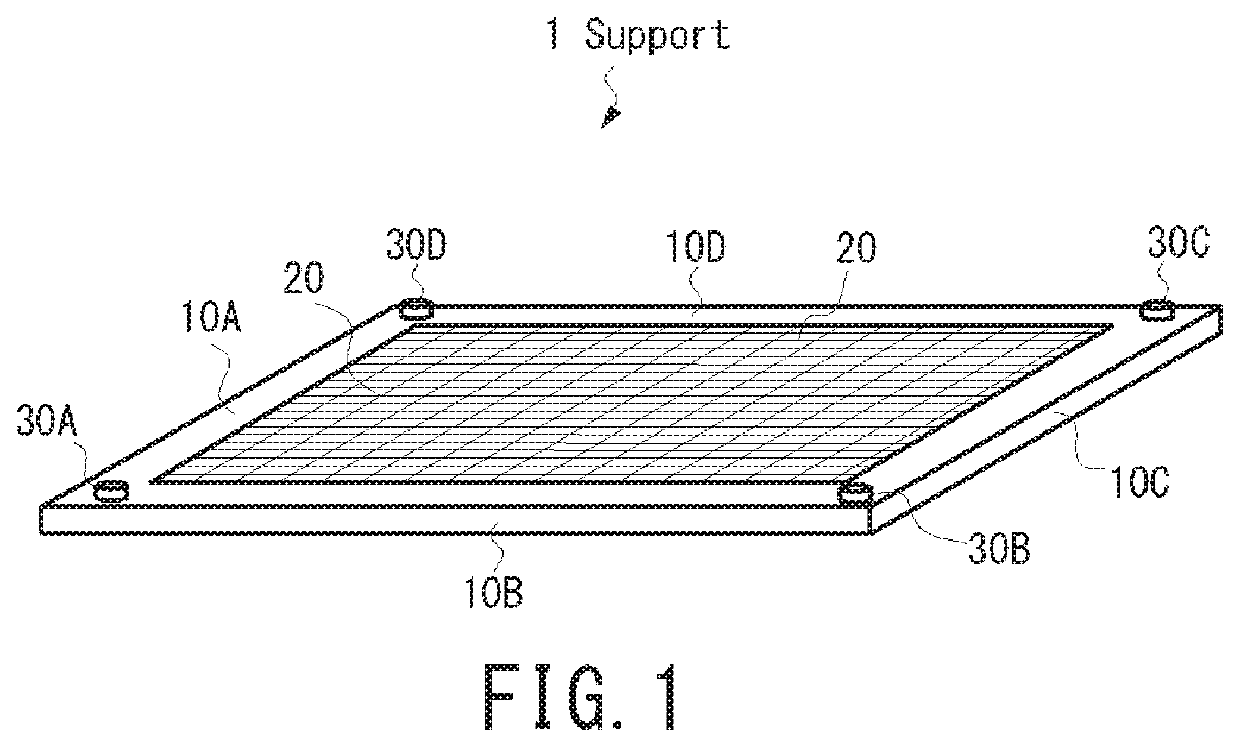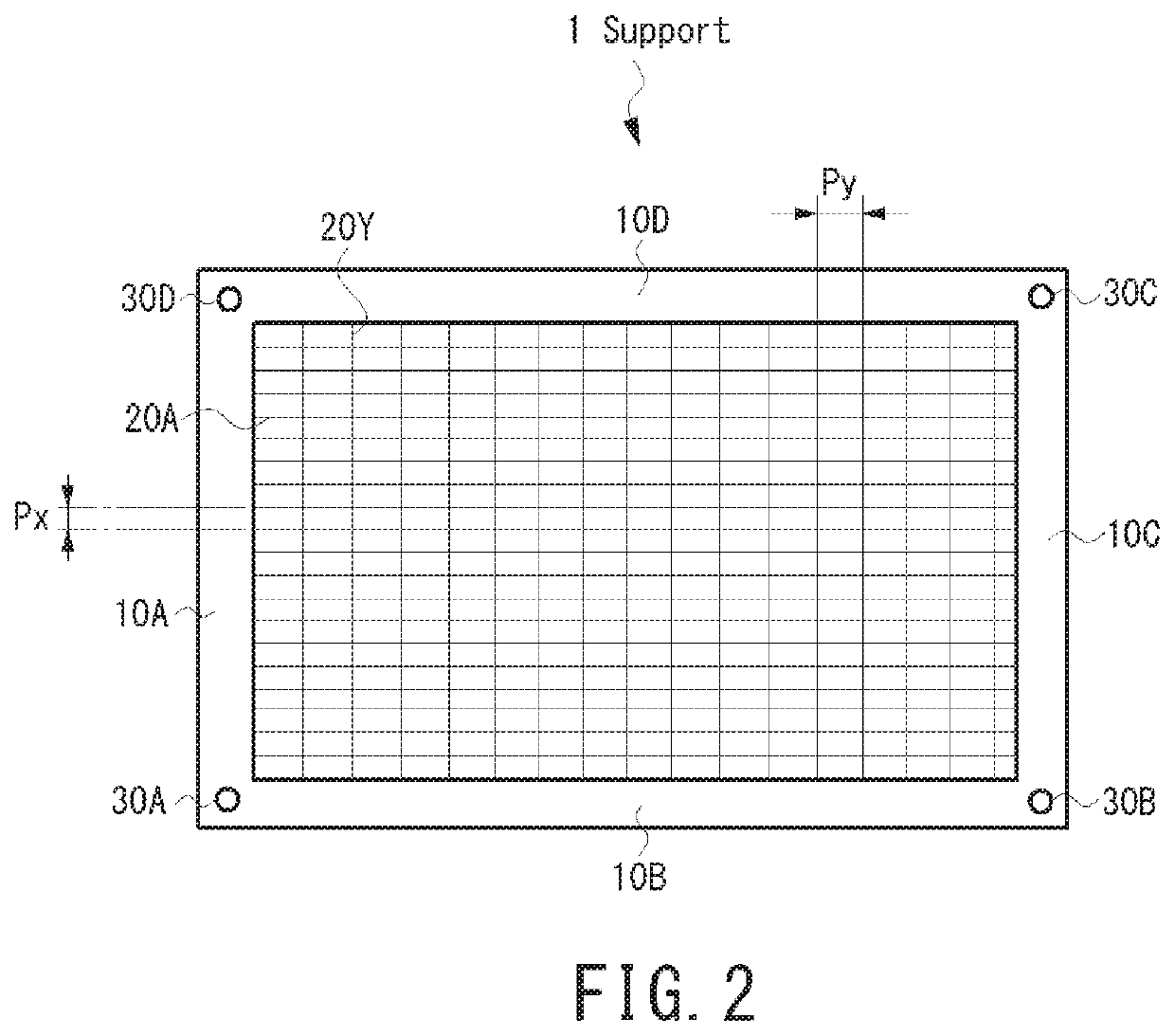Manufacturing method and device for three-dimensional engineered tissue
- Summary
- Abstract
- Description
- Claims
- Application Information
AI Technical Summary
Benefits of technology
Problems solved by technology
Method used
Image
Examples
first embodiment
[0054]Below are explanations of embodiments. FIG. 1 is perspective view of first embodiment of support for three-dimensional cellular structure fabrication. FIG. 2 is plain view of the support shown in FIG. 1. FIG. 3 is Rear view of the support shown in FIG. 1. Support 1 comprises a frame 10A, frame 10B, frame 10C, and frame 10D forming four side of frame (called hereinafter frame 10 as a whole frame), multiple string member forming net or matrix shaped space inside of frame 10, alignment measure to align each frame when layered.
[0055]Frame 10 can be made of arbitrary materials, such as resin. Also, size of frame 10 can be any size, as an example one side length can be 3-4 cm and thickness can be 0.1-1.0 mm when cell aggregate size is around 200 um.
[0056]String Member 20 exists in direction of X and Y inside of frame 10. String member 20 can be made with materials such as stainless steel, nylon, polyester, and diameter can be 10 um as one example. Preferably string member 20 is coat...
second embodiment
[0072]FIG. 12A shows schematic diagram of support used for In this embodiment, support 1 has string member 20x in x direction is located in width Lx, and string member 20y in y direction is located in width Ly. From this, support 1 has net shaped space only in between width Lx and Ly. Area 25, which does not have string member, will not hold cell aggregate which is dispensed from dispenser 200. Consequently, three-dimensional cellular structure is formed on Width Lx, Ly area.
[0073]The above mentioned example used rectangular space Lx, Ly, but space shape can be different. For example, as shown in FIG. 12B, multiple rectangular space S1, S2, S3 and S4 can be formed inside of support. In this case, four three-dimensional cellular structures which have corresponding shape to S1, S2, S3 and S4 are obtained at one process.
[0074]In second embodiment as well as used in first embodiment, multiple support shall be layered according to the height of designed three-dimensional cellular struct...
seventh embodiment
[0097]Next, the seventh embodiment is described. FIGS. 22A-22C show how 3D support is made by 3D Printer. In this embodiment, this 3D support is called as mold 700. Mold 700 is made with non-toxic material to human being. Preferably, mold 700 is made with material such as polycarbonate which has high melting temperature for high temperature sterilization. Also preferably, mold 700 is coated with non-adherent material to prevent cell adhesion to mold.
[0098]Mold 700 comprise, as shown in FIG. 22A, upper part 710 and lower part 720. Upper part 710 and lower part 720 possess net shaped area where cell aggregates are held and they are made by 3D printer. When cell aggregate is filled in mold and cell aggregate is fused, in order to remove three-dimensional cellular structure from mold 700, mold 700 is separated to upper part 710 and lower part 720 at cutting position Dv.
[0099]Upper part 710 comprises top and side members. Multiple filling holes 702 are connected to the inner space on the...
PUM
 Login to View More
Login to View More Abstract
Description
Claims
Application Information
 Login to View More
Login to View More - R&D
- Intellectual Property
- Life Sciences
- Materials
- Tech Scout
- Unparalleled Data Quality
- Higher Quality Content
- 60% Fewer Hallucinations
Browse by: Latest US Patents, China's latest patents, Technical Efficacy Thesaurus, Application Domain, Technology Topic, Popular Technical Reports.
© 2025 PatSnap. All rights reserved.Legal|Privacy policy|Modern Slavery Act Transparency Statement|Sitemap|About US| Contact US: help@patsnap.com



